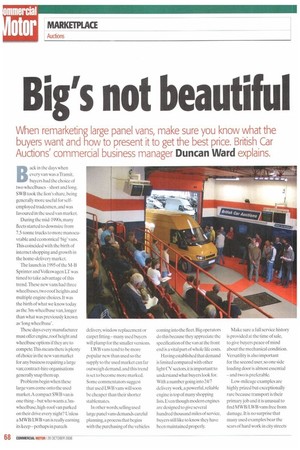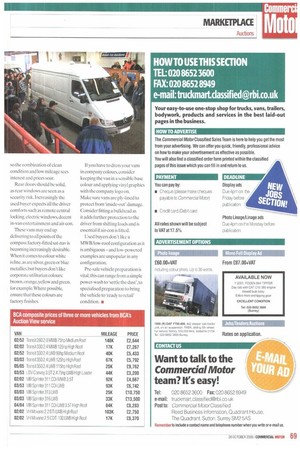Big's not beautiful
Page 68

Page 69

If you've noticed an error in this article please click here to report it so we can fix it.
When remarketing large panel vans, make sure you know what the buyers want and how to present it to get the best price. British Car Auctions' commercial business manager Duncan Ward explains.
Back in the days when every van was a Transit, buyers had the choice of two wheelbases —short and long. SWB took the lion's share, being generally more useful for selfemployed tradesmen, and was favoured in the used van market.
During the mid-1990s, many fleets started to downsize from 7.5-tonne trucks to more manoeuvrable and economical 'big' vans. This coincided with the birth of internet shopping and growth in the holm-delivery market.
The launch in 1995 of the M-B Sprinter and Volkswagen LT was timed to take advantage of this trend. These new vans had three wheelbases, two roof heights and multiple engine choices. It was the birth of what we know today as the 3m-wheelbase van, longer than what was previously known as long wheelbase'.
These days every manufacturer must offer engine,roof height and wheelbase options if they are to compete.This means there is plenty of choice in the new van market for any business requiring a large van; contract-hire organisations generally snap them up.
Problems begin when these large vans come onto the used market. A compact SWB van is one thing —but who wants a 3mwheelbase, high-roof van parked on their drive every night? Unless a MWB/LWB van is really earning its keep —perhaps in parcels delivery, window replacement or carpet fitting —many used buyers will plump for the smaller versions.
LWF3 vans tend to be more popular new than used so the supply to the used market can far outweigh demand, and this trend is set to become more marked. Some commentators suggest that used LWB vans will soon be cheaper than their shorter stablemates.
In other words,selling used large panel vans demands careful planning, a process that begins with the purchasing of the vehicles coming into the fleet. Big operators do this because they appreciate the specification of the van at the front end is a vital part of whole life costs.
Having established that demand is limited compared with other light CV sectors, it is important to understand what buyers look for. With a number going into 24/7 delivery work, a powerful, reliable engine is top of many shopping lists. Even though modern engines are designed to give several hundred thousand miles of service, buyers still like to know they have been maintained properly. Make sure a full service history is provided at the time of sale, to give buyers peace of mind about the mechanical condition. Versatility is also important for the second user,so one side loading door is almost essential —and two is preferable.
Low-mileage examples are highly prized but exceptionally rare because transport is their primary job and it is unusual to find MWB/LWB vans free from damage. It is no surprise that many used examples hear the scars of hard work in city streets
so the combination of clean condition and low mileage sees interest and prices soar.
Rear doors should be solid, as rear windows are seen as a security risk. Increasingly the used buyer expects all the driver comforts such as remote central locking, electric windows, decent in-van entertainment and air-con.
These vans may end up delivering to all points of the compass; factory-fitted sat-nay is becoming increasingly desirable. When it comes to colour white is fine, as are silver,green or blue metallics, but buyers don't like corporate utilitarian colours: brown,orange,yellow and green. for example. Where possible, ensure that these colours are factory finishes If you have to dress your vans in company colours, consider keeping the van in a sensible base colour and applying vinyl graphics with the company logo on.
Make sure vans are ply-lined to protect from 'inside-out' damage. Consider fitting a bulkhead as it adds further protection to the driver from shifting loads and is essential if air-con is fitted.
Used buyers don't like a MWB/low-roof configuration as it is ambiguous —and low-powered examples are unpopular in any configuration.
Pre-sale vehicle preparation is vital; this can range from a simple power-wash to 'settle the dust',to specialised preparation to bring the vehicle to 'ready to retail' condition. •
























































































































































































